#he’s the most average forgettable man you’ve ever seen and that’s actually what makes him terrifying
Explore tagged Tumblr posts
Photo

Star Wars, The Generations
Time to talk about “Star Wars: The Last Jedi.”
(I’m going to assume that by now, Sunday of opening weekend, you’ve seen the movie, because, if you haven’t, a: what’s wrong with you? and b: why are you reading my blog?)
In a terrific piece for Vulture.com, @abrahamjoseph discusses “Last Jedi” as the first truly populist Star Wars movie. [http://www.vulture.com/2017/12/rey-parents-star-wars-last-jedi-populism.html] I fully agree with Abraham’s reading, but I’d add a further observation: it’s the first story in the Skywalker saga to honestly address tensions between generations– in particular, tensions between the Baby Boom generation and the generations that have come to adulthood since its rise, Generation X, and the Millennials.
George Lucas was the avatar of the Boom generation, and his obsessions, fantasies, political beliefs, life choices, myopias, and sense of destined self-importance are all hallmarks of the generation he embodied and spoke to.
Rian Johnson is a true representative of Generation X, a talented and gifted man whose singular voice has been muffled by the presence of aging giants taking up creative space around him. If Johnson had arrived on the scene in 1972 with a film as smart and accomplished as his debut “Brick,” I could easily imagine him having been embraced as were Lucas or Spielberg or Friedkin, and given the same opportunities they received for far less accomplished debuts. (“THX-1138,” for all its technical achievements, suffers from an intellectual coldness of execution; no one ever has made a case for “Sugarland Express” as other than pleasantly forgettable; and the less said about “The Night They Raided Minsky’s,” the better.) But Johnson, and his fellow Generation-X directors, men and women, came of age as young filmmakers in the early 2000s– an age dominated by Baby Boom filmmakers like Spielberg, Lucas, Cameron, et al. Johnson’s opportunities (and theirs) were diminished. To contrast, in the ten years starting with “Sugarland,” Spielberg made eight films; Johnson made three. Not everyone is a Spielberg, of course, but it’s a fact the Baby Boom generation sucked up most available funding for filmmaking between the mid-1970s and the late 2000s. Talented filmmakers like Rian Johnson (and fellow Generation-X director Patty Jenkins) paid their bills and honed their skills directing television, where they contributed (with other shut-out Generation-X creatives) to an explosion of remarkable narrative experimentation unequalled on the big screen itself.
Ironically, the director of the first new Star Wars film, J.J. Abrams, seems to have more in common with the aesthetic, emotional, and political concerns of the Boomer generation than his fellow Gen-Xers, possibly because, at age 51, his childhood in the late Sixties and early Seventies was surrounded by the Boomers’ cultural triumph. Rian Johnson and Patty Jenkins grew up as the Boomers’ idealized liberal world collapsed into Reaganesque cultural exhaustion.
It’s this ‘80s collapse of the Boomer’s liberal dream into conservative exhaustion that informs Rian Johnson’s aesthetic and narrative approach to “The Last Jedi.”
Episode VIII, unlike Episode VII, recognizes the Boomer fantasy of cultural and political renewal through rebellion and the power of elitist “destiny” actually ended in disappointment, failure, and despair. The Baby Boomer Rebels who fought an Evil Empire that invaded the jungles of Endor and burned Ewok villages (an easy Boomer metaphor for U.S. miltary action in Vietnam) ultimately collapsed into a corrupt generation of disillusioned idealists. Those despairing former idealists then empowered the rise of a new militarism, unopposed by an out-of-touch political establishment so distant from average citizens its destruction is a barely noticeable flicker in the sky.
Rian Johnson deconstructs the myths of the Baby Boom generation that adopted Star Wars as its foundational fiction. The rebellion against the Empire produced not a healthy new Republic but a remote and disconnected government with no productive impact on the lives of its poorest, weakest citizens (Rey and Finn). The heroes of the Rebellion either retreated when confronted by failure to fulfill their “destiny” (Luke), turned back to their previous lack of convictions (Han), or soldiered on in an attempt to reclaim old ideals in the face of diminishing odds (Leia). Thirty years after the death of Emperor Palpatine nothing really has changed in that Galaxy long ago and far away. It’s a bleak recognition the 1960s Boomer Revolution was an utter political failure (but not a cultural failure, since we live in a culture that pretends to realize Boomer ideals).
To be fair, Abrams nods toward these notions in “Force Awakens” but undercuts their impact by hewing closely to the undergirding mythic structure of the original Boomer-fantasy “Star Wars.” The idea that destiny and mysticism will produce ultimate victory is a Boomer trope thoroughly embraced by “Force Awakens” and totally dismantled by “Last Jedi.” At every turn, in this latest film, Rian brings to bear the judgmental eye of a somewhat cynical Generation-Xer– surprisingly, and pointedly, not just upon the self-serving fantasies of Baby Boomers, but on the inexperienced surety of the generation following his own, the Millennials.
Just as Luke, Han, and Leia are revealed as heroes with feet made substantially of clay (Leia comes off best of the three, but again, notably, is out of action when crucial decisions must be made), the four featured Millennials in the story are also subjected to Rian’s cool Gen-X appraisal. Kylo, Rey, Finn, and Rose embody familiar traits of today’s Millennial generation.
With Rey, we are presented with the idealistic Millennial archtype– a passionate young woman who embraces the professed beliefs of an earlier idealistic generation, even when she doesn’t quite understand them. (The Force is a “power that helps you move things.”) She’s hopeful, convinced the old ways can restore justice, even though those old ways failed before. She hasn’t come into her own yet. She still seeks strength and validation from others. She wants to be rescued, but slowly, over the course of the story, realizes she must do the rescuing. Her idealism is as yet untempered by experience, but the disappointments she experiences both with Luke and Kylo finally make her stronger than ever.
With Finn, we find a Millennial beaten into submission by a system that appears impossible to resist. His first instinct is always to escape any way he can– but opposing that instinct, and empowering his initial rejection of the First Order’s ruthless militarism, is a strong sense of empathy. Instinct tells him to run; empathy makes him run toward those in need. The first time he sees Rey, in “Force Awakens,” he thinks she’s in danger and impulsively runs toward her. His first word on waking in “Last Jedi” is “Rey!” Even when he’s about to flee the doomed Resistance fleet, he’s combined his instinct to run with an instinct to protect. Like Rey, at the beginning of “Last Jedi” he isn’t who he will become by the end. He’s conflicted, uncertain, immature, and inexperienced. He learns a lot hanging out with Rose.
Rose, Finn’s new friend, is the most emotionally developed and self-aware Millennial in this group, possibly because she’s had the benefit of a close relationship with an admired older sister. Rose knows who she is and what she believes. She has enough experience in life to understand the structural injustice that underpins the Galactic order, and is dealing with the kind of personal tragedy that gives one perspective. Of all the Millennials in “Last Jedi” she changes the least during the story because she’s already who she will always be: a capable, brave, empowered woman who knows her place in this world– a worker and doer, not a dreamer.
And Kylo. Kylo Ren is the most obviously political figure in “Last Jedi,” the embodiment of alt-right Millennial nihilism. Feeling abandoned by his late-life, self-involved Boomer parents, attacked with suspicion by the substitute parent who became terrified by his potential, embraced and manipulated by a cynical monster, another substitute father– Kylo Ren is Millennial rage incarnate. He embraces anonymity behind a mask while striking out in unbridled anger against all who oppose him (sub-redit, anyone?) and yet, pathetically, yearns for the approval of a woman he scorns. If Rey is the light side of idealism, the promise of hope, Kylo is the dark side of idealism thwarted, the nihilism of despair. Rage is the expression of Kylo’s hopelessness, not its source.
This is a fundamental difference between Lucas’s vision of the dark side of the Force and Johnson’s. To Lucas, the eternal Boomer idealist, the dark side was always incomprehensible– the explanation he provides for Anakin Skywalker’s turn to the dark side in the prequels never feels right. (Tellingly, in the original trilogy, Vader’s origin is never explained.) Because Lucas himself wasn’t thwarted in pursuit of a dream, never faced exclusion from the idealistic fantasies of the Boomer generation, never despaired from lack of hope– he couldn’t articulate what gives the dark side of the Force its bleak alure. “Fear” and “anger” are meaninglessly abstract without personal context. Rey and Finn are often angry and fearful, but is there ever a real question they’ll despair? Even in their darkest moments they cling to hope. Why does Anakin succumb to the dark side? Lucas doesn’t really know, and the manner in which he structures Anakin’s story provides easy answers but not convincing ones.
Rian Johnson, however, the Gen-X filmmaker initially thwarted pursuing a career must understand the seductive lure of despair. He can empathize with Ben Solo, and make his embrace of the dark side comprehensible, in a way Lucas could not with Anakin Skywalker. (Or J.J. Abrams, who portrayed Kylo’s dark side persona as a combination of twisted ancestor-worship and petty father resentment.) Johnson’s approach to Kylo Ren is tempered with sadness and maturity. It’s the sighing judgment of a Gen-X middle manager watching a potentially valuable younger employee destroy himself. Such a waste, but so understandable.
This aspect of the complicated Generation-X perspective brings me to the two Gen-X characters in “Last Jedi,” who, fittingly for Gen-X, may seem less important compared to the colorful and dominant Boomer and Millennial stars, but prove to be the heart and soul of the moral argument at the core of this great movie: Poe Dameron and Vice-Admiral Holdo.
On the surface, Poe Dameron is very much a Han Solo knockoff– the cocky, smart-talking pilot who achieves the impossible with style. In Episode VII, by Boomer-influenced J.J. Abrams, that’s all he was, and apparently, until Oscar Isaac made a case for continuing the character, he wasn’t even intended as more than a one-off. With Rian Johnson at the helm, however, Poe becomes a crucial figure whose character arc encapsulates the lessons Johnson seeks to impart with this film: victory isn’t achieved by miracles, it isn’t only a product of self-sacrificing heroism, it’s hard won, complicated by tough choices, and sometimes what needs to be sacrificed isn’t a life– but the notion of heroism itself. Poe begins the movie believing victory is possible only if you’ll dare to pay the price; by the end, he understands “victory” isn’t victory if the price is life itself. That’s an incredible statement for an American blockbuster to make (a theme underscored by Rose preventing Finn from making the ultimate sacrifice himself). In 2017, after 16 years of America fighting an unending war with no “victory” in sight, it’s as political a statement as the original Star Wars metaphor of Empire trampling the jungles of Vietnam/Endor.
But there’s another side to the Generation-X cynism about war’s futility: , the fact that, despite cynicism, and awareness the battle might not be worth the price, Gen-X is still willing to do what needs to be done. Knowing hope may be unjustified, the Gen-Xer still hopes. This conflict between cynicism and hope is at the heart of the Generation-X dilemma, and at the heart of “Last Jedi.” That conflict, with its ultimate decision in favor of hope, is given form and power in the noble sacrifice of Vice Admiral Holdo.
Vice Admiral Holdo is the older, wiser, unimpressed but still hopeful Generation-X leader who understands the risks of action and so refuses to act recklessly. She didn’t start the war– the Boomers did. She inherited it. She wants to minimize damage and salvage what she can. She knows, when the bill comes due, she’s the one who must pay it– and she does, without hesitation, because that’s what the men and women of her generation always do. She cleans up the mess Leia and the Resistance leaders left behind. She guides the retreat. She does what must be done. Practical and blunt, she has no time for Poe’s heroic bullshit. Because she knows the Resistance may never achieve what the Rebellion tried to accomplish, she understands despair, but she’s too busy dealing with the problems before her to indulge it– or to hope. She does what’s necessary. It’s what Generation-Xers always do. Even if it means flying a cruiser at light speed into a First Order fleet.
Great movies reflect an era through the eyes of artists who embody that era. George Lucas embodied the era of Baby Boom “destiny” and self-conceit (“I’m the most important individual in the Galaxy because of my mystical understanding of reality”). Rian Johnson embodies our era of diminished heroism, cynicism and near despair– tempered by the hope, if we can but learn from our heroes’ mistakes, that somehow, some way, some day, we may yet restore balance to the Force.
567 notes
·
View notes
Text
Epic Movie (Re)Watch #113 - Groundhog Day
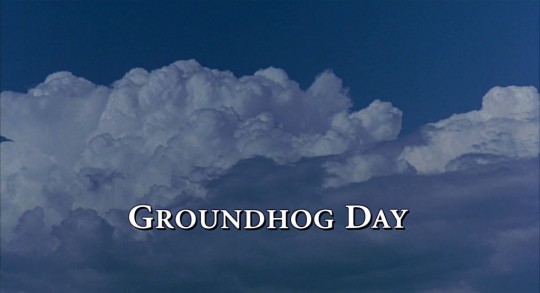
Spoilers Below
Have I seen it before: Yes
Did I like it then: Yes.
Do I remember it: Yes.
Did I see it in theaters: No.
Format: DVD
1) This film is a holiday classic associated with one of the less popular American holidays out there. Hell, this film probably made Feb. 2nd an even bigger deal than it was before.
2) The first thing we experience as an audience member of George Fenton’s quirky score over the opening credits. Fenton’s music I think is one of the more underrated aspects of the film as there is a lot of range to this particular score. There is the quirky comedy music, the kinda faster actiony stuff, but my favorite part is the romantic score featured in this film. You should give the soundtrack a listen if you have the opportunity, it’s pretty damn good.
3) Bill Murray as Phil Connors.

Director Harold Ramis, who frequently collaborated with Murray (mostly notably in the two Ghostbusters films) originally wanted Tom Hanks to play Phil but thought he was, “too nice,” and hired Murray instead. That’s great for us as the audience, because the role is one of Murray’s best. He is able to believably take us through this journey of character, playing the lovable but jerky Phil in the beginning with just as much believability as the guy who’s actually trying to do some good at the end. Murray’s improv is on full display with the film and that helps with the reality of his character.
Unfortunately, this would be the last film Murray and Ramis would collaborate on. An ongoing debate between whether the film should be more dramatic (Murray’s stance) or comedic (Ramis’ stance) was a contributing factor. As well as this, according to IMDb:
Bill Murray was undergoing a divorce at the time of filming and was obsessing about the film. He would ring Harold Ramis constantly, often in the early hours of the morning. Ramis eventually sent writer Danny Rubin to sit with Murray and iron out all his anxieties, one of the reasons why Murray stopped speaking to Ramis for several years.
I don’t know if they ironed out their issues before Ramis’ untimely death in 2014, but I hope so.
4) Chris Elliott as Larry.
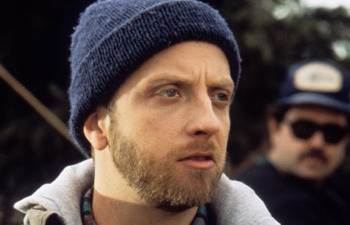
This is probably Elliott’s most famous role, which is saying something considering he’s mostly the comedic camera man who’s tired of Phil’s bull. But Elliott’s performance makes it funny and memorable, delivering some of the best lines in the films (more on that later).
5) Andie Macdowell as Rita.

Rita is actually a character who is surprisingly well developed but in a lot of little ways, and I’ll elaborate more on that as I go. MacDowell is wonderful in the part, making Rita a positive upbeat person but believably so instead of just a “life force” character. She plays Rita (and it is written) with some flaws too which helps make her interesting, but again more on that later. Her biggest asset is probably that she can hold her own with Bill Murray in a scene. You can tell (or at least I can guess) in certain scenes that Murray is improvising and that MacDowell is sharp on her toes with a comeback. It makes their relationship a believable one. Especially considering there is a line later how Phil fell for Rita as soon as he saw her. You can sort of see that when you look for it. It’s small, but it’s there. A testament to both actors.
6) Although this film takes place in Punxsutawney, PA it was actually filmed in Woodstock, IL. I was there back in fall of 2015 and the town square where they filmed most of it is pretty much still the same. They even have a black on the corner where Bill Murray stepped into the really bad puddle. It was pretty cool. (Only this time however did I realize one of the signs style reads “Woodstock Jewelers”.)
7) Remember how I said Larry has some great lines/observations?
Phil [after Rita says she booked him a nice hotel]: “You know I think this is one of the traits of a really good producer: keep the talent happy.”
...
Larry [to Rita, after Phil has left]: “Did he just call himself the talent?”
8) “I Got You Babe”, the Sonny & Cher song that plays every morning when Phil wakes up, was the song that was in the very first draft of the script and carried through until the end. The song probably became more popular (or at least, popular for a longer time) BECAUSE of its use in this film.
9) Ned! Ryerson!
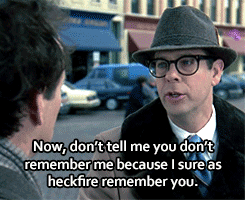
Like a lot of characters in this film, Ned Ryerson could have just been a throw away and forgettable little gag. This guy who supposedly knows Phil from high school and is an insurance agent now. But actor Stephen Tobolowsky totally MAKES this role. There’s nothing insincere about Ned. He doesn’t feel like a leech, he feels like an overly enthusiastic and genuine guy who’s absolutely hysterical. Tobolowsky plays Ned over the top in the tradition of Abbott & Costello and it works wonderfully!
Also Ned has the best lines.
Ned: “Am I right or am I right or am I right? Right? Right right right right!”
Ned: “Watch out for that first step there, it’s a DOOZEY!”
These lines on there own are not necessarily interesting but Tobolowsky just gives them such life it is a treat to watch.
10) This film has so many great lines.
Police Officer [when Phil is out in the street in a blizzard, trying to get to Pittsburg]: “Now you can go back to Punxsutawney, or you can freeze to death.”
[Phil takes a minute to stand in the snow. He looks back at Punxsutawney and then at the road ahead.]
Phil: “I’m thinking.”
11) There is never an explanation given as to why Phil is relieving Groundhog Day over and over again. I think in one draft of the script it was a spell cast by a jilted lover, but in the final film and for most drafts there’s no explanation. I think that’s the reason the film works so well. It’s not some Harry Potter fantasy. It’s just a comedy/drama with one fantasy element.
12) It’s fun rewatching this film again because you get to realize that characters who just have a throw away line earlier in the film end up being like Phil’s piano teacher or the drunks he meets a few Groundhog Days later.
13) I love that when Phil asks Rita for a good hard slap across the face she doesn’t hesitate and he’s not pissed about it. They’ve got each other. ;)
14) This line.

15) I like that Phil always goes to Rita for help with his Groundhog Day problem. She has no experience with this! There’s no reason for him to go to her with his problems other than he trusts her and respects her.
16) Hey look, it’s director Harold Ramis!
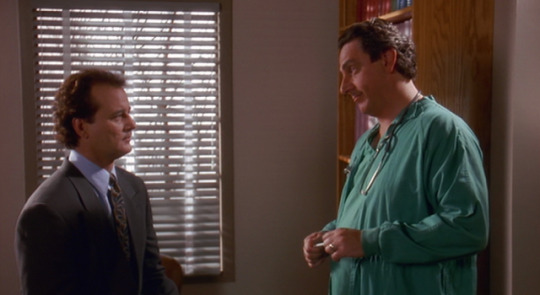
17)
Phil [to two drunks]: “What would you do if you were stuck in one place and nothing you did mattered?”
Drunk: “That about sums it up for me.”
18)
Phil [after one of the drunks decides not to drive and stumbles]: “You wanna throw up here or you wanna throw up in the car?”
Drunk: “I think...both.”
19)
Phil [while driving towards a train on train tracks]: “I’m betting he’s gonna swerve first.”
20) When Phil realizes his actions don’t have consequences the film gets fun real fast.
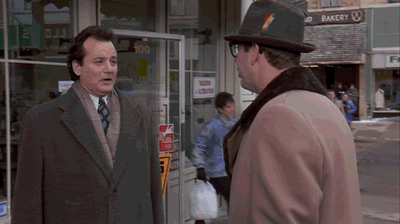
21) I find it a little pretentious that Rita’s reaction to this:
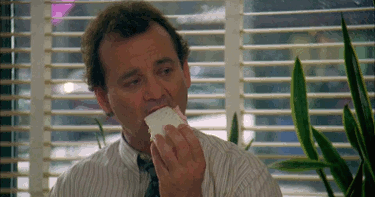
Is to quote a Sir Walter Scott poem at him which says he’s egotistical. Like, really? You’ve got this whole poem memorized JUST to call people egotistical? I mean I like it from a writing standpoint, it makes her kind of flawed, but also she comes off as pretentious. Not that she’s wrong, it’s just she’s very in your face with it.
22) The original plan for this film is that we as the audience would not see the start of the loop, instead just picking up on an “average” day and wondering how Phil knew the things he did. Harold Ramis promised he wouldn’t change this to the screenwriter but ended up changing it anyway (I think with the screenwriter’s blessing, but maybe not). I think this works better. It allows us to invest in Phil as a character more.
23) Phil’s attempts to seduce Rita - I think - start out with him trying to genuinely get to know her. He asks her about her life and only then goes down the route of, “Who’s your perfect guy?” I think he does have real feelings for her he just doesn’t know how to handle them in a healthy way so he uses this time loop to his advantage.
24) It’s interesting to see the repeated attempts of Phil trying to win over Rita, with each mistake done over until it’s not a mistake. You can tell that each time is a little less sincere, and the times when they connect the most are typically when he’s being honest with her and just letting things happen.
25) Another flaw of Rita’s:
Rita: “What should we drink to?”
Phil: “To the groundhog!”
Rita: “I always drink to world peace.”
THEN WHY THE HELL DID YOU ASK HIM WHAT YOU SHOULD DRINK TO!?!? I like it, it fleshes out her character, but it’s an annoying thing to find in a real person (and I know men and women who act like this).
26) I have so many questions.
Rita [on her ???? date with Phil]: “Do you ever have deja vu?”
Phil: “Did you just ask me that?”
This is the only time we EVER have another character show a hint of someone being aware of something is going on. WHY RITA!?!? WHY NOW!?!? WHAT IS HAPPENING!?!?!?
27) The best example of what I was talking about in note 24 is the snowball fight Phil & Rita have with the kids. Phil didn’t know that was going to happen, he didn’t know what Rita was going to say, that’s the first time he ever got that far. And he’s being honest with her! It’s such a nice scene between the two of them. And then when he tries to recreate it the next Groundhog Day it feels super awkward, incredibly forced, and wildly uncomfortable.
28) I think this is such an incredibly important concept.
Phil [after Rita says he’ll never love anything because he only loves himself]: “That’s not true! I don’t even LIKE myself!”
Keeping this in mind as Phil begins his downward spiral tells you A LOT about his character. And it’s that downward spiral that pushes this film from fun comedy to great movie.
29) And you thought this would be a light hearted comedy!
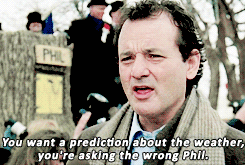
Phil: “I’ll give you a winter prediction. It’s gonna be cold. It’s gonna be gray. And it’s gonna last you the rest of your life.”
30) At one point Phil throws his radio on the ground and the speaker/song is still going.
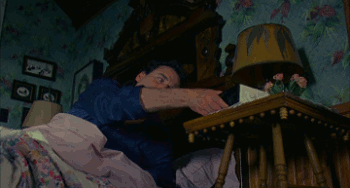
According to IMDb:
The scene where Phil picks up the alarm clock and slams it onto the floor didn't go as planned. Bill Murray slammed down the clock but it barely broke, so the crew bashed it with a hammer to give it the really smashed look. The clock actually continued playing the song like in the movie.
31) The entire scene with the car chase and the quarry, where Phil kidnaps the groundhog and attempts suicide (which is a more entertaining scene than it sounds), is very well done. It shows just how desperate Phil is to end this nightmare. And it also gave us some pretty great lines.
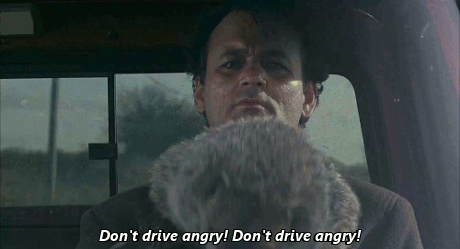
Larry [after Phil drives into the quarry and the car crashes]: “He might be okay. (Car explodes) Well no, probably not now.”
32) The montage of Phil’s attempts at suicide is good for two reason: it gets across where he is at this point in the film, and it’s short. If it were too long this scene would get too depressing too fast.
33) I love this fucking scene.
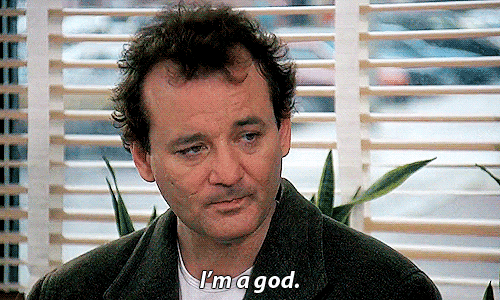
Phil has relieved the same day over and over again for what has probably been years and he’s so damn tired he just wants to talk to someone about it. So what does he do? He goes to Rita. He tries to convince Rita and succeeds wonderfully. This scene is a prime example of this film’s beating heart, of why it’s a great feel good movie. Phil knows everybody! He knows all their stories, their names, everything about them, because he’s been living the same day over and over again. It’s wonderful. Even without trying it all just sinks in. And guess what? He knows Rita the best.
Phil: “You like boats but not the ocean. You go to a lake in the summer with your family up in the mountains. There's a long wooden dock and a boathouse with boards missing from the roof, and a place you used to crawl underneath to be alone. You're a sucker for French poetry and rhinestones. You're very generous. You're kind to strangers and children, and when you stand in the snow you look like an angel.”
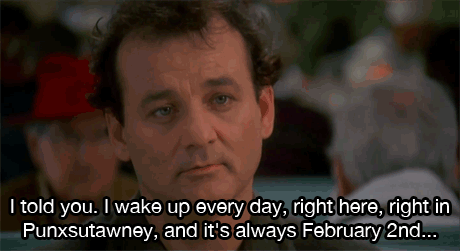
THIS is why I love this film! This emotion! This heart! And there is a beautiful piece of score on the soundtrack called, “You Like Boats But Not The Ocean,” which sums those feelings up perfectly in music and I love that too! Everything about this just makes me feel good! Also how strange and insightful a little detail about Rita like, “you like boats but not the ocean,” is!
34) And so begins the good Phil tour. The amazing final act of the film where Rita has convinced Phil that he can maybe do some good with this “curse” of his and which carries the same wonderful emotion that was present in the diner scene where Phil convinces Rita he’s serious.
35) Bill Murray improvised this:
Phil [after Ned comes up to meet him and he hugs Ned]: “I don’t know where you’re going but can you call in sick?”
36) But even as Phil works to helps people’s life, he can’t save everyone.
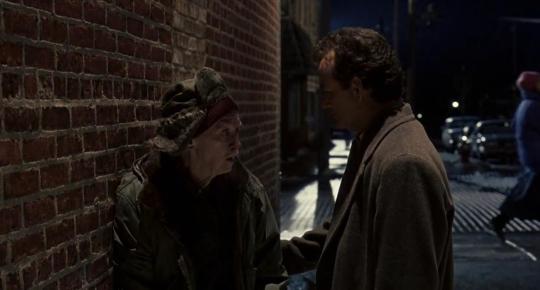
This old homeless man is someone who Phil passes everyday and, when he starts acting kind, gives a ton of money to everyday. Towards the end of the film Phil meets the man and takes him to the hospital where he dies. So the next day Phil tries to save him. He takes him to a restaurant, gives him a big meal, and the man still dies. The man dies everyday. And that scene is heartbreaking and adds such weight to the film and I love how sad it makes me every single time.

I wish I were this kind, but honestly I’m scared to be. I’m scared to be taken advantage of but there are people out there who need help and hopefully I’ll be better about giving it in the future.
37) If you pay attention to the people in the background at the hospital you’ll see this kid:
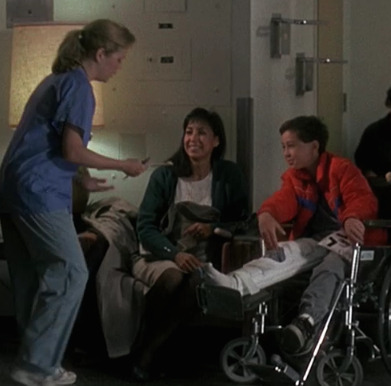
Remember that kid. You only notice him when you’ve watched the film ten times (that’s not a hyperbole either), but remember him.
38) The final Groundhog Day is a wonderful thing to behold. It starts with us hearing the end of Phil’s report on the groundhog.
Phil: “When Chekhov saw the long winter, he saw a winter bleak and dark and bereft of hope. Yet we know that winter is just another step in the cycle of life. Put standing here amongst the people of Punxsutawney, and basking in the warmth of their hearts and hearths, I couldn’t imagine a better fate than a long and lustrous winter. From Punxsutawney, it’s Phil Connors. So long.”
And EVERYONE is paying attention to it, hell rival news networks are recording it! It’s THAT moving!

39) Do you remember the kid?
youtube
Continuity! (Boom)
40) The final party is a great scene too. It’s the culmination of probably Phil’s best Groundhog Day yet. He helped as many people as he could and even plays for their pleasure at the party. It is his least selfish and the only time in the film we ever see the party, even though it was happening every single night. And also Rita spends $300+ to win Phil in a bachelor auction when the highest bid before that was $60.
41) Kneel before Zod!


42) I love this.
Phil [after ice sculpting Rita]: “I know your face so well I could’ve done it with my eyes closed.”

43) And then tomorrow finally happens.
youtube
A great end to a great film.
Groundhog Day is just amazing. It has a heartwarming story, a feel good vibe, an intriguing concept, and a wonderful cast. It is just so good for so many different reasons and if you haven’t seen it yet you should. Right now.
#Groundhog Day#Bill Murray#Andie Macdowell#Harold Ramis#Chris Elliott#Epic Movie (Re)Watch#Movie#Film#GIF
27 notes
·
View notes
Text
Madden NFL 20 Review - Some Stumbles, No Fumbles
New Post has been published on https://gamerszone.tn/madden-nfl-20-review-some-stumbles-no-fumbles/
Madden NFL 20 Review - Some Stumbles, No Fumbles
Continuing the Madden franchise’s recent tradition of story modes, Madden NFL 20 introduces a new narrative campaign. This new mode generally falls flat, but the pro football sim stands out on the field, with new additions that faithfully capture the essence of the NFL experience while making it fun to play again and again.
The new story mode, QB1: Face of the Franchise, replaces the Longshot story mode that was featured in Madden 18 and 19. Unlike those campaigns, which featured a pre-set character, Madden 20’s QB1 mode lets you create an entirely unique football star and guide him through the final stages of his collegiate career with the hopes of making an NFL starting roster, and, on a longer timeline, complete a journey to hoisting the Lombardi Trophy at the Super Bowl.
QB1’s story picks up as you decide which college to attend and play for. However, the college football elements within Madden 20 are not anything significant. You select a school from 10 options, including heavyweights like Florida, Oklahoma, Texas, and Clemson. It’s a treat to see fully licensed college football teams, complete with true-to-life jerseys, logos, stadiums, and marching band songs, but the gameplay experience in reality is limited to two games in the College Football Playoffs–and you can’t play the college teams in quickplay later on.
After winning the National Championship against all odds, you’re off to the NFL Combine where your performance in front of scouts and GMs determines how high you go in the draft. There are some genuinely funny moments here with your aloof agent Les Moore, and interactions with him are some of the best character moments in the story mode. After making it to the NFL, the game then disappointingly becomes the standard Franchise mode, except your character has more backstory that acts as fuel to drive you to succeed on the field. That’s the idea, at least; in practice, it leaves much to be desired.
In part, that’s because QB1’s cinematic cutscenes and Telltale-style choices end once you get to the NFL. At that point, the narrative beats play out through text messages you receive from fans and other players from around the league. This delivery method makes conversations awkward and ultimately forgettable. There is one storyline in particular involving a sick child rooting for you that falls flat; it tries too hard to tug on your heartstrings, moody piano pieces and all, without earning any payoff. Without giving too much away, another major storyline in QB1 involves your college teammate and friend, and it ends abruptly, with the strong suggestion that the story will continue in Madden NFL 21. That’s too bad, because this character, in the limited screen time he gets, is far more interesting than the cookie-cutter, run-of-the-mill one you create.
In general, QB1 moves at such a fast pace that it doesn’t allow for thoughtful character development. Not only that, but the story that QB1 does tell is hokey and clumsily unraveled. The story overall feels barebones and incomplete, with the entirety of the QB1 mode feeling like a half-baked idea in the end.
Despite the lackluster story and the way it’s delivered, QB1 succeeds in connecting you to your on-field performance and inspiring you to improve or play differently each week once you’ve made it to the NFL. The text message system, while not the best avenue for full conversation, is better utilized in delivering week-to-week objectives and challenges. You can complete these to earn XP, which you can then invest into your character in an RPG-lite-like system where you choose which aspects of your game you want to develop.
As an example, I responded with some trash talk against one of the league’s best cornerbacks, Richard Sherman, and my Game Day Goal, as it’s called, was to achieve 400 yards or more of offense and a 60-yard pass–not an easy task with Sherman in the backfield. The system is dynamic and responsive to what happens on the field week-to-week, and this is a nice touch that provides a further level of connection to your character and their status in the league.
Madden 20’s standard Franchise mode, which is separate from the QB1 mode, gets a welcome update this year. Its implementation of the new Scenario Engine, which lets you interact with players and coaches through the aforementioned text-message system, is the best new feature for Franchise. Like with QB1, having weekly objectives that you decide on is a compelling way to keep you interested and engaged in a 16+ week season that can otherwise get monotonous and repetitive. However, Franchise mode overall doesn’t get any other significant or meaningful updates this year, which might be a bummer for seasoned players wanting more.
Perhaps the biggest and most exciting change for Madden 20 are the new X-Factor and Superstar abilities. 50 of the league’s best players have been given these super abilities, and they revamp the fundamentals of Madden playmaking. X-Factor abilities are unlocked when you meet the qualifications to get “in the zone”–for some QBs, it’s throwing for 5 or more yards in the air multiple times without making a mistake–while Superstar abilities are passive traits tied to your player that are always active.
The new X-Factor abilities are truly game-changers, and they further emphasize the distinction between the average NFL player and elite athletes. For example, the Gambler X-Factor ability–which only Aaron Rodgers has–makes it impossible for AI defenders to intercept his passes. Similarly powerful X-Factor abilities are available for defenders as well, and that helps balance things out. Not only that, but X-Factor abilities can be lost quickly; a QB who takes a sack is immediately out of the zone, while dropped passes and fumbles also cancel out these abilities.
These abilities, when combined with an elite player like Madden 20 cover star Patrick Mahomes (who has incredible baseline stats to begin with), become overly powerful in some instances. Mahomes’ unique passive Superstar abilities give him immense speed and dexterity out of the pocket, on top of his already powerful and accurate arm. When teammate Travis Kelce unlocks his own X-Factor ability (which gives him a guaranteed aggressive catch on any single-man coverage), it becomes simply too easy to complete big plays down the field.
Outside of that issue, the new X-Factor and Superstar abilities introduce a level of strategy that the Madden series has never seen. I found myself often weighing up whether I should pursue the X-Factor qualification conditions or choose lower-risk plays that are more likely to be successful. At pivotal stages, like in the fourth quarter or in a third-and-long situation, this level of risk/reward is heightened. Not only that, but with 50 X-Factor abilities spread across players on the 32 NFL teams, it encourages you to try new teams and strategies.
Importantly, X-Factor abilities do not feel gimmicky or too overpowerful for the most part as they’re difficult to unlock and have numerous counters. Stephon Gilmore of the New England Patriots, for example, has an X-Factor ability called Acrobat that allows him to perform a diving move where he makes an incredible pass breakup. Some pass-rushers, too, including Aaron Donald of the Los Angeles Rams, can shred the defense and break the O-Line easily to sack the quarterback for a big loss. The saying “any given Sunday” is truer than ever in Madden 20 thanks to the X-Factor abilities.
Overall, the on-field action in Madden this year is better than ever. The game provides more on-screen info than last year’s iteration, making it easier to see things like decision-making specifics (such as average yards-per-play or yards given up) and which elite offensive and defensive players have X-Factor and Superstar abilities. This makes for an easy way to help you see the odds of having success with a play before the snap. The playbook menus (and menus overall, for that matter) are cleaned up and brighter, which helps you see important information at a glance.
Also new this year are Run-Pass Options added to playbooks. These hybrid plays provide yet another way for play-callers to mix things up and keep defenders guessing. There are also numerous player-specific animations, including Aaron Rodgers’ signature quick release and Patrick Mahomes’ sidearm throw. This all works together to make Madden 20 closer than ever to replicating the look and feel of actual pro football. Nothing in the updated gameplay mechanics for Madden 20 is as substantial as the introduction of Real Player Motion from last year, but the controls in Madden are as good as they’ve ever been thanks to further refinement on last year’s improvements and the introduction of some welcome tweaks and small changes. A subtle gameplay change for 2019 is that you can double press the receiver icon to pump fake; this small change makes it easier than ever to trick a defender into biting on a pass route, providing yet another level of depth and control.
The core fundamentals that underpin Madden 20’s gameplay feel more solid and dependable than ever. Mistakes like poor passes, missed tackles, and bad decision-making are yours and yours alone to own because the controls rarely, if ever, let you down.
Also notable for Madden 20 is what’s (generally) not there: bugs. After many hours with the game, I only experienced a handful of minor glitches, though your mileage may vary, and it’s worth noting that you can continue to expect other oddities like out-of-place commentary and some sideline players executing the same animations all the time. I also experienced what felt like an unusually high number of facemask calls and injuries.
Now in its third year using EA’s Frostbite engine, Madden 20 also looks very good with its better-looking player models that have richer detail and more realistic flourishes (except for Greg Olsen; what happened there?). The Madden 20 game engine also provides gorgeous environmental effects like glistening sun rays peeking through the clouds and casting shadows on the field and snow effects that limit your vision and force you to suggest playing more conservatively to accommodate for the wintry conditions.
The commentary team composed of Brandon Gaudin and Charles Davis also return in Madden 20, and they are consistently a treat to listen to. Despite some lines being repeated from time to time (how many times do we have to hear that Julian Edelman was a quarterback in college or that Tom Brady was initially drafted to play baseball?), the pair deliver the right mixture of lines that keep you informed and engaged in equal measure. Madden 20’s overall broadcast, presentation, and gameplay packages aim to replicate the real-life NFL experience, but it continues to be a shame that the voicelines–at least all the ones I heard in over 20 hours with Madden 20–do not comment on real-world NFL issues. As with previous years, the commentary will be updated regularly throughout the season.
Among Madden 20’s other modes is the fantasy team-building card-based Ultimate Team, and this continues to be the game’s richest when it comes to the sheer multitude of challenges to complete. It remains a thrill to build a fantasy team and compete either against other fantasy AI teams or the world at large through online play.
A subtle yet enjoyable change for MUT this year is how you can move from one challenge to the next without returning to the menu screen, which is great considering how many there are to complete. There is also a new “Mission” system that helps you select the right challenges to complete in order to acquire items for your deck. In years past, MUT could feel like a hard-to-parse system that you slogged through waywardly, but the new system gives you more direction, and as such it is more respectful of your time.
Ultimate Team does have issues with microtransactions, however. At the very start, the tutorial instructs you to visit the store where you can make real-money purchases, which feels like an unnecessary nudge toward spending extra. As with past iterations of MUT, it can feel like a grind to get the cards you want, which in turn encourages you to consider spending money on microtransactions when you otherwise might not. That rubbed me the wrong way, but MUT overall is still an enjoyable and engaging mode that I expect to return to again and again.
Madden NFL 20 is an improved version of the annualized professional football series that excels in some areas and leaves something to be desired in others. The new QB1 career mode–which includes a barebones NCAA football experience–overall feels like a half-baked idea that doesn’t deliver anything meaningful or interesting. When it comes to the on-the-field action, however, the new X-Factor and Superstar abilities shake up the familiar gameplay formula to give seasoned players and newcomers alike a fresh way to scheme plays and orchestrate strategy on both sides of the ball.
Source : Gamesport
0 notes